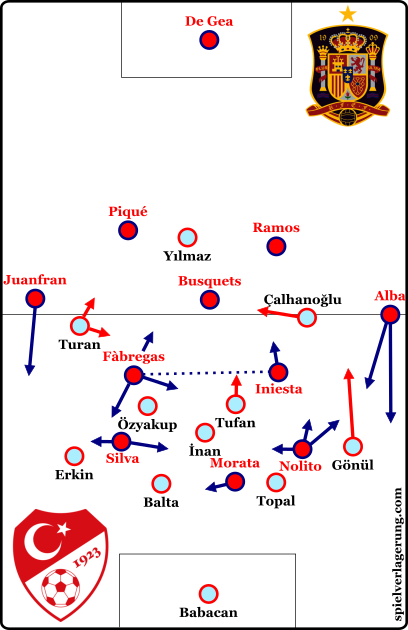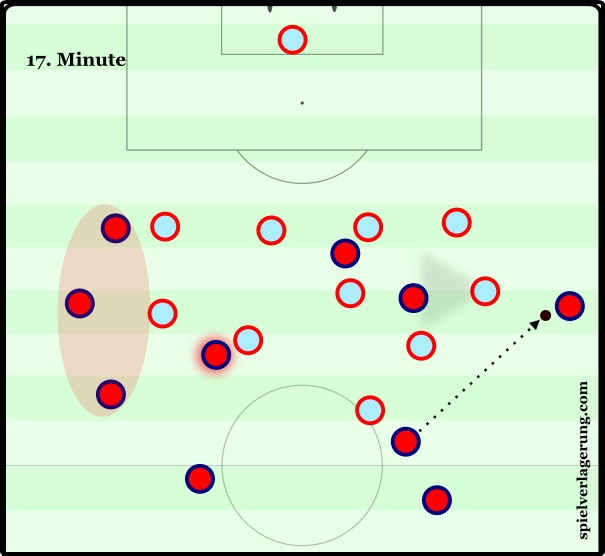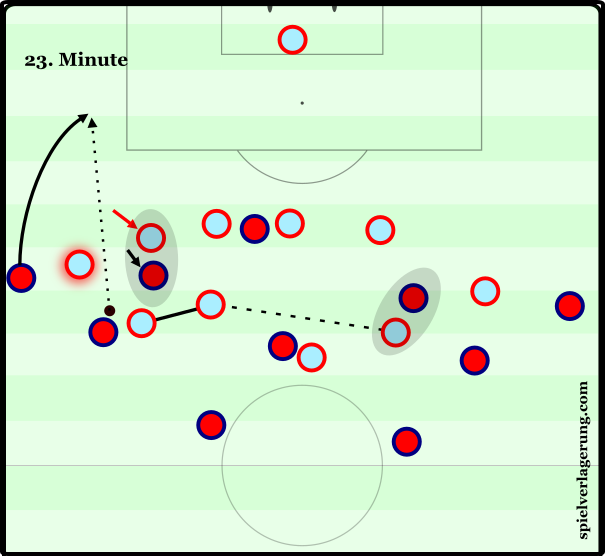Spain impress despite possession issues
Spain threw their hat in the ring for the title of “most impressive team” with their 3-0 victory over Turkey on Friday night. A stellar performance from Celta’s Nolito saw Spain overcome their issues with their build up play.
Lineups
 Vicente del Bosque named an unchanged side from the one that snatched a late victory against the Czech Republic in Spain’s opening game. Alvaro Morata continued to cement his place upfront for the Spaniards, while Nolito was preferred again to Chelsea’s Pedro on the left. Cesc Fabregas kept his place in the midfield containing Sergio Busquets and Andres Iniesta, despite receiving criticism for his performance on Monday.
Vicente del Bosque named an unchanged side from the one that snatched a late victory against the Czech Republic in Spain’s opening game. Alvaro Morata continued to cement his place upfront for the Spaniards, while Nolito was preferred again to Chelsea’s Pedro on the left. Cesc Fabregas kept his place in the midfield containing Sergio Busquets and Andres Iniesta, despite receiving criticism for his performance on Monday.
Fatih Terim, on the other hand, made a solitary change. Cenk Tosun was dropped after the Turks’ defeat to Croatia, with the Besiktas striker being replaced by the more internationally experienced Burak Yilmaz. The Turkey boss kept faith in the midfield which started the previous game, choosing to keep Dortmund’s Nuri Sahin on the bench for a second consecutive match.
Turkey’s Midfield Coverage
With Spain being expected to dominate possession, the work of Turkey’s midfield to protect their defensive line would be crucial if they were to even hope of taking a positive result through to their final group game. As Spain got the ball, Turkey would drop into a low block, keeping vertically compact through the middle. The central midfield three – Selcuk Inan, flanked on his right by Ozan Tufan, and his right by Oguzhan Ozyakup – did a fine job in the initial part of the match to limit Spanish penetration through the centre of the pitch.
The outside central midfielders looked to maintain pressing access to Spain’s central players through loose man-orientations. Occasionally such man-orientations would result in a lack of horizontal compactness, especially on the weak side. In situations where the ball was on one flank, the ball-far central midfielder could be seen checking away from Inan instead of making a ball-oriented shift to cover, instead favouring to maintain access to either Iniesta or Fabregas. When not faced with a direct opponent – when Fabregas or Iniesta dropped deeper – Tufan and Ozyakup would stay compact and defend in a more position-oriented fashion.
Selcuk Inan’s role in the centre of the midfield three was similar. Mainly position-marking between his midfield partners, offering cover as they pressed in wider areas, he would also be available to pick up any extra players Spain moved into the defensive block.
The roles, however, of Turkey’s wide midfielders was not as conducive to compactness. Turan and Hakan Calhanoglu would occasionally track the runs of Jordi Alba and Juanfran as they made their first advancement. While this gave the Turks good access to the Spanish fullbacks, it also essentially ceded the centre of the pitch. With Turkey defending in a situational 6-3-1 when both Alba and Juanfran pushed up to the offside line, Fatih Terim’s side were left with the midfield three defending on their own against the might of the Spanish backline and midfield – especially since they were afforded scant protection from Yilmaz up front. While they looked to mitigate against horizontal switches through the man-orientation mechanism mentioned earlier, this opened up large gaps within the midfield unit which could be exploited.
Initial Spanish flaws

Spain’s lack of ball-oriented shift leaves the right flank cripplingly underloaded. With three players outside the Turkish block on the opposite flank, Spain are effectively playing with reduced numbers. Furthermore, Juanfran has no option to play inside other than to go back to where the ball originally came from.
Despite this, Spain were largely unable to penetrate the Turkish midfield for the opening 25 mins. With poor central and halfspace occupation, the holders were restricted to ineffective crosses from wide areas. It was not uncommon during this period to see three Spanish players on the same flank, all outside the Turkish block. This was more the case on the left hand side, where Nolito would offer width without any balancing movements from Alba or Fabregas, since David Silva’s movement would primarily take him infield – often as far as the centre of the pitch.
A significant factor in Spain’s ineffective possession during those stages was their poor connectivity. While Fabregas and Iniesta would frequently swap positions, the Chelsea midfielder would often double up with his midfield partner around the left halfspace, without offering any passing lanes to either the ball-carrier or potential receivers. This isolation effectively led to Spain playing with one redundant player in what was already a compact midfield, and resulted in reduced opportunities for penetration.
Moreover, Fabregas’ movements over to the left halfspace had repercussions on the opposite side. In cases where moved to that side of the pitch without a counter-balancing movement from Iniesta, David Silva and Juanfran were left isolated on their flank with a considerable underload. To make matters worse, Spain occasionally opted to switch the ball to this side. While playing to an underloaded side is a useful way to shift an opposition block to one side before exploiting the opposite one through a quick switch, this is only possible through ball-oriented movements from central midfield players – creating an outlet for the ball to pass through on its way to the target side. Fabregas’ forays into the left side were not matched by subsequent ball-oriented movements capable of forming connections, leaving the David Silva and Juanfran isolated on the right, with no option but to restart the attack by going backwards, and often losing the ball.
Nolito: Spain’s unexpected fulcrum
Enter Nolito. The Celta forward, preferred to Pedro, was instrumental in providing opportunities for Spain to penetrate the Turkish midfield. Despite playing a less positionally dynamic game than David Silva, it was the small movements he made which helped Spain so much in this regard. Playing on the left wing, he frequently made movements to counter-balance those of Alba and in particular Iniesta. Simply by making these small movements, the distances and angles which Turkey’s midfielders had to cover became much more uncomfortable.
His movements into the left halfspace, and Spain’s ability to find him there, proved to be the turning point in the match. As mentioned in the analysis of England’s draw over Russia, dynamic positioning can be a useful tool in overcoming stubborn defences. In Nolito’s case, his movements – both infield and away from goal – demanded a reaction from Turkey’s right back, Gokhan Gonul. Defending in a strongly man-oriented manner, as Gonul did throughout the game, has the consequence of making the defending player reactive. Gonul – who looks far more comfortable going forward than he does going the other way – was forced into making snap-decisions as to whether or not to stay with Nolito as he made these moves, or to hurriedly arrange for another Turkish player to pick him up.

Nolito’s inward movement drags Gonul out from his berth at right back, leaving a huge gap for Iniesta to slide a pass through for the onrushing Alba. Gonul’s motion towards the centre of the pitch leaves him no chance to recover. Also visible here are Turkey’s midfield orientations, with the ball-far midfielder favouring a man-oriented role over one which would keep compactness in the centre.
In this sense, the right back was caught in a catch 22. Go with Nolito towards the middle of the pitch, and he would leave his area completely free for Alba or Morata to move into; stay in his position, and Nolito would take advantage of the disorganisation in the Turkish midfield to receive unopposed, and attack the defensive line directly.
This was particularly evident in Spain’s superb third goal. As Nolito received the ball on the touchline, he was met by Gonul, who then proceeded to follow the Spaniard all the way across to the edge of the D. So far out from the defensive line as to be potentially called a situational midfielder at this point, Alba was able to ghost in with ease to receive Iniesta’s magical pass and set up Morata for the clincher.
More open second half
Even before the third goal, the second half was a much more open affair than the first. With Turkey forced to either push men forwards to try and salvage something from the match or disappear with a whimper, there was much more space for Spain to exploit vertically. In addition to this, the runs of Alvaro Morata gave Spain the option to push the Turkish defence back, opening more space in front for the likes of Nolito and Silva. Not blessed in the required departments to be greatly effective in tight areas, Morata stayed clear of the tight combination play areas, instead preferring to stretch Turkey’s defence in areas away from the ball, creating larger spaces between units.
With Turkey not offering much going forward at all, Spain’s defenders were able to take some liberties. In the build-up phase, it was not uncommon to see one of Ramos or Pique directly involved, at times even orchestrating the bottom of the midfield triangle if one of the more advanced midfielders had pushed higher. Both fairly quick as far as central defenders go, this gave them the ability to play with an extra active player in possession, while still being able to recover sufficiently to deal with counter attacks, despite being left 1v1 at the back.
Their cavalier approach did not end there, however. Both central defenders were very aggressive in tracking the backwards runs of players between the lines. Ramos and Pique both exhibited examples of this, with the former stepping out some distance on one occasion – leaving Pique 1v1 – and the latter being caught out with a clever layoff in the dying minutes, giving up an excellent chance for Turkey to score their first of the tournament.
Conclusion
It was clear in the second half that Turkey were not going to seriously trouble Spain. The introduction of Dortmund’s Nuri Sahin was a change made in an effort to add a creative spark to what had been a midfield without great impetus in the first half. Despite this, Fatih Terim’s side struggled to create anything of note. Terim changed to a 5-4-1 midway through the half in an attempt to defend more aggressively between the lines, but at this point Spain were comfortable and cruising.
In the end it was comfortable for Vicente del Bosque’s side. Strolling through the second half it would be easy to gloss over the entirely forgettable opening minutes. However, to rely on individual performances to cover up the team’s failings is of course unsustainable. As fantastic as Nolito and Iniesta were on Friday night, Spain will need to address the first 25 minutes of that performance if they are to harbour serious intentions of winning the tournament for the third successive time.


Keine Kommentare vorhanden Alle anzeigen